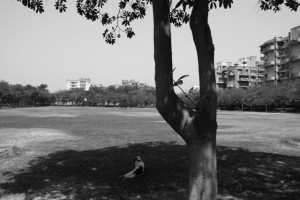‘A western disturbance is affecting north Pakistan and adjoining Jammu & Kashmir. This brought about the change in weather over Delhi and some other parts of northwest India. However, the city will continue to remain hot and we do not see the impact of the disturbance lasting for more than a day or two,’ informed the Met department. Uncharacteristically, the prediction proved true. And good. Good because the morning following the rain was quite hot and muggy with humidity closing in on 75 per cent. The report ended with a grim ‘The heat wave will continue for some more time. There is no clarity on the onset of monsoon over Delhi either.’ Australia and Philippines only added to the weather-watchers’ woes.
‘El Nino’ means ‘little boy’ in Spanish. Like most little boys – at least those in Spain – this one throws a lot of tantrums and is unpredictable and erratic. Probably the behavioural patterns which prompted the weathermen to give the name to an unusual warming of the ocean surface around equatorial Pacific. Australia’s Bureau of Meteorology reported that though temperatures in the tropical Pacific were still within normal range, the ocean was most certainly warming up. This has been inextricably linked to a bad southwest monsoon in India. The Bureau said that ‘the warming trend will continue over the coming months…the tropical Pacific will approach or exceed El Nino thresholds by the end of winter (August)’. El Nino has started playing truant already: our Met department, in its first outlook released on April 26, had predicted a normal monsoon with rains at 99 per cent of the long term average. But by June, 61 per cent of the country had received deficient rains which was 25 per cent below normal.Tagalog territory had a new dampener in store – a tropical depression called ‘Talim’. The Philippines’ state-run weather bureau said Talim was gathering strength in the South China Sea and could develop into a typhoon which had the power to halt the monsoon although temporarily. As with storms in South China Sea that move east, Talim has the ability to sap the energy of the monsoon. Talim was formed as an aftermath of a typhoon named Guchol that took place in the region towards the mid of June and had headed into Japan. Depending on the direction in which it was headed, Talim could be expected to aid or stand in the way of the Indian monsoon.
Come El Nino or Talim, our Met department is gung ho about the prospects. “The monsoon progress is slightly behind schedule,” said the current director general, L. S. Rathore. “But such delays are usual.” The Department went a step ahead and even reiterated its earlier forecast of a 99 per cent monsoon. Might sound a bit too optimistic but not difficult to believe going by both El Nino and Talim being dependent on a host of factors. A weak El Nino in 2002 unleashed a drought year after 14 years of good monsoon. Seven years later, the phenomenon ‘coincided’ with the worst monsoon the country had witnessed in 40 years. Then, on the flipside, the strongest El Nino ever was in 1997 which didn’t dent the monsoon at all. On the Talim-front, D. Sivananda Pai, lead monsoon forecaster of the Met department, is cautious but positive. “Since the storm (in the South China Seas) is moving eastwards, it can adversely affect the monsoon temporarily. But other local systems like western disturbances may cancel out Talim’s effect. How these competing factors play out remain to be seen.”Late June, Delhi is still grappling with high temperatures – maximum closing in on 46 degrees Celsius and minimum hovering around 32 degrees Celsius, which is four degrees above normal. Met officials are non-committal about fixing any date for the onset of monsoon. “The normal date of onset of monsoon over Delhi is July 1 (not June 29), but as things stand, it will definitely not come by then,” an official said. “Progress of the monsoon cannot be predicted with certainty so early on. A date for Delhi will only be given once the system reaches at least Lucknow,” he added.
Then, once the monsoon reaches Lucknow, isn’t Delhi just a ramble away!
At sunrise, or soon after 5 a.m. houses must be closed, only a small door being left open for communication with the outside world… Man and beast languish and gasp for air… Vegetation suffers equally; almost all green things wither; the grass seems burnt up to the roots; bushes and trees seem moribund; the earth is as hard as a paved highway; the ground is seamed with cracks; and the whole landscape wears an aspect of barrenness and sadness. The heat is truly fearful. J.M. Merk, describing the summer of Punjab, 1880















Not much has changed for the summers of Punjab since Mr Merk’s ‘truly fearful’ experience!